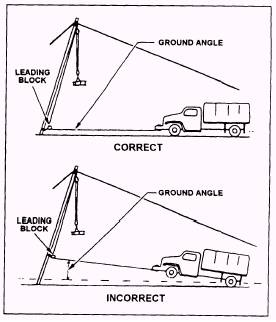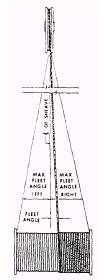|
WINCHES Vehicular-mounted winches and engine-driven winches are sometimes used in conjunction with tackles for hoisting. When placing a power winch to operate hoisting equipment, you must consider two points. First, you must consider the angle with the ground that the hoisting line makes at the drum of the hoist. This angle is sometimes referred to as ground angle, as shown in figure 13-47. The second point to consider is the fleet angle of the hoisting line winding on the drum, as shown

Figure 13-47.-Vehicle winch used for hoisting.

Figure 13-48.-Fleet angle of winch. in figure 13-48. The distance from the drum to the sheave is the controlling factor in the fleet angle. When you are using vehicle-mounted winches, the vehicle should be placed in a position which permits the operator to watch the load being hoisted. A winch is most effective when the pull is exerted on the bare drum of the winch. When a winch is rated at capacity, the rating applies only as the first layer of cable is wound onto the drum. The winch capacity is reduced as each layer of cable is wound onto the drum because of the change in leverage, resulting from the increased diameter of the drum. The capacity of the winch maybe reduced by as much as 50 percent when the last layer is being wound onto the drum. Ground Angle If the hoisting line leaves the drum at an angle upward from the ground, the resulting pull on the winch will tend to lift it off the ground. In this case, a leading block must be placed in the system at some distance from the drum to change the direction of the hoisting line to a horizontal or downward pull. The hoisting line should be overwound or underwound on the drum as may be necessary to avoid a reverse bend. Fleet Angle The drum of the winch is placed so that a line from the last block passing through the center of the drum is at right angles to the axis of the drum. The angle between this line and the hoisting line as it winds on the drum is call the fleet angle. As the hoisting line is wound in on the drum, it moves from one flange to the other, so the fleet angle changes during the hoisting process. The fleet angle should not be permitted to exceed 2 degrees and should be kept below this if possible. A 1 1/2-degree maximum angle is satisfactory and will be obtained if the distance from the drum to the first sheave is 40 inches for each inch from the center of the drum flange. The wider the drum of the hoist, the greater the lead distance must be in placing the winch.
|

